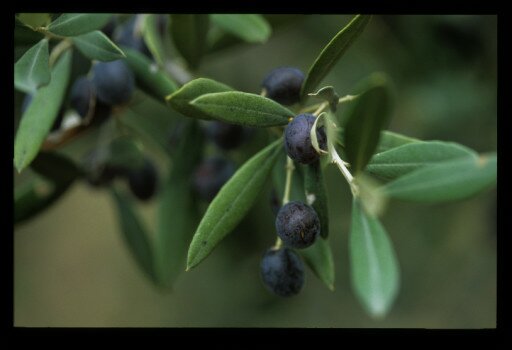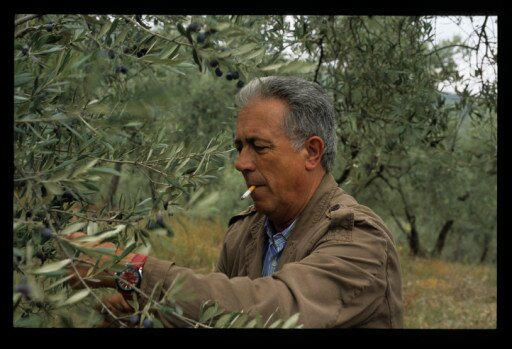The Fall of Quince from Tin House, Winter 2005
One late arid night this summer in the Spanish city of Zaragoza, I gorged myself on too many tapas. Grilled sardines, rice-stuffed blood sausages, flash-fried baby octopi, bold chorizo—all washed down with robust house wines. I was shooting location photos for a cookbook, which meant doing a thorough tour of the bars. My palate was sated, a rebellion was burgeoning in my stomach, and I was lonely for my girls back home in Barcelona. From my father-in-law, Tomàs, I knew a tonic for at least two of the ailments: carne de membrillo (usually called just membrillo), sweet jellied paste made from the quince fruit.
I crossed the vast, empty plaza in front of the Basílica de Nuestra Señora del Pilar, an impressive pilgrimage sight that enshrines the jade pillar on which the Virgin Mary stood in an apparition to Saint James, and walked up a narrow feeder street looking for a bar. I stepped into one dominated by the mounted head of a toro. They didn’t have membrillo. Too wearied to look further, I drank a glass of chilled fino instead.
The next morning, while photographing in the cavernous modernista Mercado Central, I found some lush, ruby-hued artisanal membrillo, and bought a deck-of-cards-sized piece for the train ride home that afternoon.
Once the spires of Zaragoza had faded and the train was speeding through salty-white landscape broken with brittle trees and sporadic whitewashed farmhouses, I cut up the membrillo with a penknife, layering thin slices like shingles along fresh bread. It was firm, chewy, granular, with the dense taste of wild berries, shades of fresh apple, and the sweet cloyingness of ripe figs.
Native to Persia and Anatolia, and possibly Caucasus, the quince arrived—before the apple—into the Levant and southeastern Europe, where a superior form of the fruit was cultivated on the island of Crete. It is a member of the rose family (Rosaceae) and a relative to the apple and pear, especially resembling the latter in a lumpy, oversized way. Weighing up to a pound each, they ripen late in autumn, turning from green to a lemony-gold covered with a fine pubescent down. The flesh is hard, woody, and grainy, fragrant, astringent.
But that tang of bitterness—in the form of a wispy slice—is a perfect balance for fresh goat cheese. Cooked, the quince’s bitterness dissipates altogether. When Tomàs was growing up in rural western Catalunya, his mother used to boil and then slowly pound them with olive oil and garlic into a floral quince allioli to accompany grilled lamb or any hare or game birds his father shot. She also baked quinces in the oven, sometimes with sugar and cognac, other times stuffed with raisins.
My own initiation to quinces wasn’t from such traditional rustic Catalan fare, but rather from Middle Eastern and North African cuisine, where it is found in numerous duck and chicken dishes, baked stuffed with nuts and ground meats; in stews and Moroccan tagines with lamb; and in Tunisian fish couscous. During long cooking, it holds its shape and texture, exuding a potent, blossomy perfume, while the flavors gain strength and density. The high amount of natural pectin found in the seeds makes it an ideal fruit for jelling. The ancient Greeks were the first to preserve quinces, conserving them uncooked in honey—the forebear to jams, jellies, marmalades (a word first applied to quince preserve), and fruit pastes such as membrillo.
For the Greeks, the quince was an emblem of love and fecundity. In a tradition handed down well into the Middle Ages, newlyweds were given quinces before entering their new home. The fruit was held sacred to Aphrodite, who often appears with a quince in her right hand, the gift from Paris that led to the downfall of Troy and triggered the drama of the Iliad. The Boston Museum of Fine Arts has a statue of this pose, dating from 100 B.C. to 50 A.D.: a nude Aphrodite leans against a pillar, hip sallied out, hair pulled up in a knot, a quince (which the museum misidentifies as an apple) casually held out in her hand.
Yet Paris’s gift to her was from the garden of the Hesperides, where “golden apples” were guarded by the dragon Ladon. These famed golden apples of mythology are normally simply assumed to be golden-colored apples, but they are most likely quinces since Golden Delicious and similar-colored apple cultivars were not available then.
There are several other reasons to suspect mistaken identity. The Greeks often generically called tree-fruit “apples.” The Romans—who loved quinces and spread them around their empire—called the quince “melimelum,” or “honey apple.” The Roman historian Pliny the Elder, in a chapter on the quince in his encyclopedic Natural History (A.D. 77), refers to the fruit as “chrysomelum,” which means “golden apple.”
The quince is equally shortchanged in the Scriptures, where the Hebrew word “tapuach” is always translated as “apple.” Yet a “true apple was not known in Palestine in Biblical times,” wrote Robert Graves in The White Goddess, asserting that the apple in the opening of the Song of Solomon “is the Sidonian (i.e., Cretan) apple, or quince”:
As the apple tree among the trees of the wood, so is my beloved among the sons. I sat down under his shadow with great delight, and his fruit was sweet to my taste.
He brought me to the banqueting house, and his banner over me was love.
Stay me with flagons, comfort me with apples: for I am sick of love.
The homely quince seems an unlikely choice to be associated with love and with Aphrodite. It lacks the dripping sweetness or velvety skin of the peach, the supple, smooth flesh of the papaya, or the overt sexual form of a split-open fig. Being hard and lumpy and acidic, there is not the intense, almost erotic experience that comes with biting into those other three fruits. But when cooked, the quince is transformed. The flesh doesn’t break down and dissolve like most other fruits, allowing slow stewing with sugar or honey. Mashed, and then let set, it is pure textured sweetness—at its mawkish extreme, membrillo. The color also alters. When boiled, the seeds secrete a pink gel that, with further cooking, darkens to scarlet, dying the flesh a color associated with royalty, and also with love.
The smell, too, hints of love, or more precisely, virility. It’s musky, with a masculine, fresh-cropped floridity, a scent that was much appreciated by the Romans. They used the essence of quince in perfumery, and, according to Pliny, quinces were “kept shut up in the antechambers of great men, where they receive the visits of their courtiers.” A friend in Madrid does, effectively, the same, storing quinces in his closets as natural fresheners.
This hallowed fruit, though, has fallen from grace, from reverence to near obscurity in much of the world. Although popular amongst early North American colonial settlers, and once common in New England household gardens, today there are less than 200 acres of commercially cultivated quince trees in the U.S. Why? It’s interesting how we’re prejudiced against things we don’t know, or in this case, don’t eat. Today the argument made against the quince, the reason for its unpopularity, is its bitter taste.
Such judgment isn’t necessarily universal. In Turkey many children still know the quince as a snack fruit to be eaten raw. As a boy in Catalunya, Tomàs picked them from the tree, peeled them, and ate them like apples.
Though Tomàs still loves quinces, he doesn’t eat them raw anymore. I find him well-versed though briskly unromantic on such country matters. My first impression of him ten years ago was how perfectly he spun an apple on a knife like a lathe, the paper-thin peel unfurling in a single coil. He has wavy grayish hair, a trim moustache, carries lists in his shirt pocket, understands occasions, and maintains a certain rural logic. The fruit you can get in the field has nothing to do with that in the shop, a matter of market tendencies and the need to pick it underripe to allow for transport and longer shelf life. Besides, who wants to buy fruit and wait two weeks for it to ripen enough to eat? Even at its ripest, the quince is tart—eating too many, as Tomàs knew as a boy pilfering orchard fruit, gives you a stomachache.
As our collective palates deepen their need for sweetness, it was perhaps inevitable that the popularity of such an acidic fruit would gradually wane. This decline had a firm push around 1470, though, when the great Flemish artist Hugo van der Goes painted a small diptych with one panel called The Fall of Man (now in the Kunsthistorisches Museum in Vienna), which depicts Eve picking an apple for Adam. Other artists elsewhere took up this choice, filled their Gardens of Eden with apple trees, and the detail entered the Judeo-Christian tradition. The apple in Eden is so deeply instilled in us, such a strong part of popular culture, that it’s naturally assumed to derive from some sacred book. But in Genesis, the tree of knowledge is not identified as an apple tree (or any other specific tree). The tradition that van der Goes was borrowing from seems to be clearly that of the golden apples in the garden of the Hesperides, and he should have painted Eve—like Aphrodite—holding a quince instead.
Not long after returning from my Zaragoza trip, I made a small batch of codonyat, Catalan for quince paste, with—because it was summer—fruit imported from Chile. My in-laws were at the flat, and I set out a small ceramic dish of ruddy codonyat in the living room. When Tomàs tasted it, a slight smile of recognition came to his face. His mother made it every Tots Sants (All Saints’ Day) from the season’s first quinces in October. My codonyat is soft, spoonable, less firm than market-bought stuff, just as, he pleasingly noted, his mother’s was.
In school he was given bread with either membrillo or else chocolate everyday for merienda, afternoon snack. That was in the years of great poverty that followed the Spanish Civil War, when membrillo was subsistence food, inexpensive and full of sugar and quick energy. The tradition remained steadfastly in place forty years later when my wife was a schoolgirl. Partly, to be sure, because of membrillo’s restorative powers. Cervantes immortalized these four hundred years ago in Don Quixote when a court doctor advises Sancho Panza that “a hundred wafers and some thin slices of membrillo” would help his stomach and aid digestion. Cervantes wasn’t the first to write down this still-prescribed advice (recently recommended by both our daughters’ doctor and my mother-in-law). A recipe for quince paste in the 13th-century Hispano-Arabic Anonymous Andalusian Cookbook claims it “lightens the belly that suffers from bile” and “keeps bad vapors from rising from the stomach to the brain.”
“Say this fast,” Tomàs said to me, setting down the small spoon in his hand: “La tia Maria codonys collia, codonys collia la tia Maria” (Aunt Maria quince picked, quince picked Aunt Maria). It was a randy tongue twister, an old childhood favorite. I repeated it quickly and did exactly what you try not to do. Instead of the second “codonys,” I said “collons,” which is a profane way of saying “balls.” He laughed and took another bite.
I was pottering about the house while Tomàs sat in the living room doing a puzzle with our oldest girl. As I passed in and out, I caught sight of him taking small spoonfuls of codonyat. By the time he left, the dish was nearly empty.




